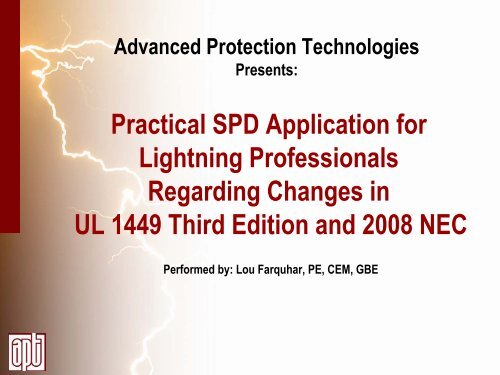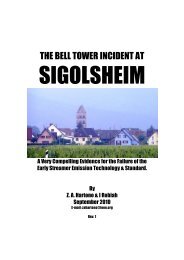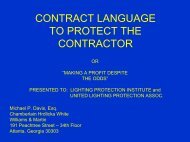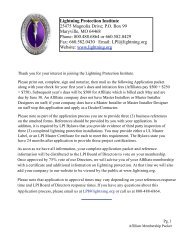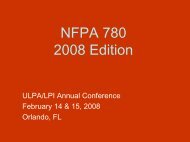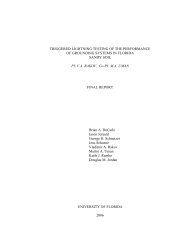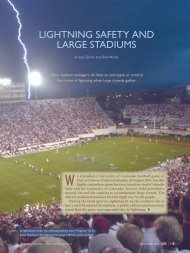Download - Lightning Protection Institute
Download - Lightning Protection Institute
Download - Lightning Protection Institute
You also want an ePaper? Increase the reach of your titles
YUMPU automatically turns print PDFs into web optimized ePapers that Google loves.
Advanced <strong>Protection</strong> Technologies<br />
Presents:<br />
Practical SPD Application for<br />
<strong>Lightning</strong> Professionals<br />
Regarding Changes in<br />
UL 1449 Third Edition and 2008 NEC<br />
Performed by: Lou Farquhar, PE, CEM, GBE
This presentation summarizes our Feb 26, 2009<br />
discussion at the ULPA/LPI Conference in<br />
New Orleans<br />
‘Regulatory Changes & What You Need to<br />
Know’ in First 19 slides<br />
Simplifying Suggestions & Why:<br />
Slides 15-17<br />
Theory & supporting info - slides 20-36<br />
UL is a registered trademark of Underwriters Laboratories, Inc.<br />
NEC and NFPA are registered trademarks of National Fire <strong>Protection</strong> Association<br />
Copyright © 2009 Advanced <strong>Protection</strong> Technologies (800) 237-4567<br />
2
Advanced <strong>Protection</strong> Technologies (APT)<br />
• 24 Years Supplying Surge Protective<br />
Devices<br />
• ISO 9001-2000 Quality Management System<br />
• ISO 17025 evaluation by UL<br />
• Power Quality Assurance magazine –<br />
PQ 50 Company<br />
• Frost & Sullivan ranked APT –<br />
Leading Supplier of Three Phase Devices<br />
• Market Engineering Customer Focus<br />
Awards<br />
• Members of UL, IEEE, NEMA standards<br />
committees<br />
Copyright © 2009 Advanced <strong>Protection</strong> Technologies (800) 237-4567<br />
3
Regulatory Changes<br />
Forcing Industry Changes<br />
Collective Surge Industry has been working behind<br />
the scenes to simplify and coordinate regulatory<br />
activities<br />
Coordinating UL 1449 Third Edition with 2008 NEC<br />
with NFPA 780, etc.<br />
This is coming to fruition now<br />
Copyright © 2009 Advanced <strong>Protection</strong> Technologies (800) 237-4567<br />
4
UL 1449 THIRD Edition<br />
Combines TVSS and Surge Arresters into one<br />
UL Standard, UL 1449 3rd Edition renamed:<br />
Surge Protective Devices (SPDs)<br />
Effective: Sept 29, 2009<br />
Surge<br />
Arresters<br />
SPD<br />
• Coordinates with 2008 NEC<br />
• New SPD Types: Types 1, 2, 3 & 4<br />
• New Voltage <strong>Protection</strong> Ratings (VPRs) replace<br />
old-style Suppressed Voltage Ratings (SVRs)<br />
• New I nominal ratings<br />
TVSS<br />
Copyright © 2009 Advanced <strong>Protection</strong> Technologies (800) 237-4567<br />
5
2008 NEC<br />
2008 NEC made substantial changes to:<br />
• Article 280 (Surge Arresters, over 1kV)<br />
• Article 285 (SPDs, 1kV or less)<br />
Surge Arresters traditionally used in <strong>Lightning</strong><br />
<strong>Protection</strong> are moved from Article 280 to Article 285.<br />
Article 285 is effectively a mix of<br />
2005 NEC & UL 1449 THIRD Edition<br />
Copyright © 2009 Advanced <strong>Protection</strong> Technologies (800) 237-4567<br />
6
UL 1449-3 & 2008 NEC Art 285<br />
Surge<br />
Arresters<br />
SPD<br />
TVSS<br />
• Surge Arrester SPDs now safety & performance tested<br />
• Unaware of existing SA that meets 1449-3 & UL 96A<br />
• ≈99% of existing SA’s become obsolete<br />
• 2008 NEC Art 285 changed based on 1449-3<br />
• Requires SCCR<br />
• Major huge expensive big deal to surge manufacturers<br />
• Bid Specifications become obsolete as product<br />
evaluation & ratings change<br />
Copyright © 2009 Advanced <strong>Protection</strong> Technologies (800) 237-4567<br />
7
UL 1449-3 & 2008 NEC Art 285<br />
Background: Surge Arrestors and TVSS perform very<br />
similar surge suppression functions, but are handled<br />
differently by regulatory agencies.<br />
NEC UL eval UL CCN Safety test? UL96A Location<br />
Surge Arrestor: Art. 280 IEEE C62.11 OWHX Not Really Yes Line Side/Any<br />
TVSS: Art. 285 UL 1449 XUHT Rigorous! ~No Load Side<br />
Solution corrected shortcomings and coincides with<br />
2008 NEC, UL 96A (Master Label), NFPA 780 (<strong>Lightning</strong><br />
<strong>Protection</strong>) and somewhat harmonize with worldwide<br />
surge nomenclature & standards<br />
Should Tie Issues Together & Be Easier to Understand<br />
Copyright © 2009 Advanced <strong>Protection</strong> Technologies (800) 237-4567<br />
8
UL 1449-3 & 2008 NEC Art 285<br />
• Changing terms ‘Surge Arrester’ and ‘TVSS’ to SPD<br />
• Creates Types 1, 2, 3 & 4 SPDs<br />
– Type 1 – Installed on line or load side of Main OCP - similar to<br />
what you knew as SSA, except now includes rigorous safety<br />
testing. Includes all OCP & safety apparatus inside SPD<br />
– Type 2 – Installed on load side of Main OCP - similar to what<br />
you know as hardwired TVSS. May require external OCP<br />
– Type 3 – Point of Utilization – direct plug in - similar to what<br />
you know as surge strips - 10 meters from panel (rational<br />
based on being IEEE Cat. A location)<br />
– Type 4 – surge suppression components, could be basic<br />
component or complete module. Type 4 components can be<br />
tested for Type 1, Type 2 or Type 3 applications.<br />
Copyright © 2009 Advanced <strong>Protection</strong> Technologies (800) 237-4567<br />
9
UL 1449-3 & 2008 NEC Art 285<br />
SPD Types: Types 1, 2, 3 & 4<br />
Based on Location within electrical distribution system<br />
(also coincides with ANSI/IEEE C62.41.2-2002 Categories C, B & A)<br />
Trans<br />
Meter<br />
Type 1<br />
Svc.<br />
Disc.<br />
OCP built in to<br />
SPD, more<br />
rigorous testing<br />
Panel<br />
10m (30feet)<br />
Type 2<br />
Type 3<br />
Copyright © 2009 Advanced <strong>Protection</strong> Technologies (800) 237-4567<br />
10
UL 1449-3<br />
Performance Test Format Changed<br />
New Testing uses Six (6) Times More Energy<br />
• As surge amplitude goes up,<br />
clamping voltage goes up too<br />
• Specs become obsolete<br />
• Need new VPRs in specs<br />
500A<br />
Old – 6kV / 500A<br />
Suppressed Voltage Ratings<br />
(SVR)<br />
3000A<br />
New – 6kV / 3,000A<br />
Voltage <strong>Protection</strong> Ratings<br />
(VPR)<br />
Copyright © 2009 Advanced <strong>Protection</strong> Technologies (800) 237-4567<br />
11
UL 1449-3<br />
I nominal Testing – In - (Nominal Discharge Current)<br />
- New Concept to USA – Originated from IEC 61643<br />
- Duty Cycle Testing<br />
- 15 8x20µs surges through every mode of three<br />
samples used for VPR testing<br />
Type 1 – 20kA or 10kA<br />
Type 2 – 20kA, 10kA, 5kA or 3kA<br />
Type 3 – 3kA<br />
Type 4 – Based on intended usage as Types 1, 2 or 3<br />
UL 96A Master Label requires<br />
20kA In from Type 1 or Type 2 SPD<br />
Copyright © 2009 Advanced <strong>Protection</strong> Technologies (800) 237-4567<br />
12
2008 NEC Art 285<br />
Copyright © 2009 Advanced <strong>Protection</strong> Technologies (800) 237-4567<br />
13
UL 1449-3 & 2008 NEC Art 285<br />
Summary:<br />
• UL 1449 3 rd Edition new standard for SPDs<br />
• Effective Sept 29, 2009<br />
• New SPD Types: Types 1, 2, 3 & 4<br />
• Performance tested - Voltage <strong>Protection</strong> Ratings (VPRs)<br />
• New I nominal ratings<br />
• Need 20kA In for UL 96A Master Label<br />
• We suggest using Type 1’s because they definitely include<br />
OCP such that you do not have to add on your own<br />
• Verify at www.UL.com under CCN VZCA<br />
• 2008 NEC Article 285 for SPDs<br />
• Need appropriate SCCR per 2008 NEC Art 285<br />
Copyright © 2009 Advanced <strong>Protection</strong> Technologies (800) 237-4567<br />
14
Simplifying Suggestions:<br />
(Why? on next slides)<br />
• Select UL Listed SPD having ‘UL Mark’<br />
• Select SPD with 20kA In rating<br />
• Select high Short Circuit Current Rating (SCCR)<br />
• Select low Voltage <strong>Protection</strong> Ratings (VPRs)<br />
• Select Type 1 SPD<br />
• Ensure short leads<br />
• This does not have to be costly!<br />
(There are basic SPD’s meeting this)<br />
Copyright © 2009 Advanced <strong>Protection</strong> Technologies (800) 237-4567<br />
15
Suggestions & Why (2 of 3):<br />
• Select UL Listed SPD having ‘UL Mark’<br />
1.) Ensures UL 96A & NEC 285.5 compliance<br />
2.) Easy to verify at www.UL.com under CCN VZCA<br />
• Select SPD with 20kA In rating<br />
1.) Complies with UL 96A Master Label & NFPA 780 4.18.3.1.2<br />
• Select high Short Circuit Current Rating (SCCR)<br />
1.) Comply with NEC 285.6<br />
2.) 100kA -200kA SCCRs almost always adequate<br />
• Select low Voltage <strong>Protection</strong> Ratings (VPRs)<br />
1.) Provide better clamping performance (your computer would<br />
rather see less voltage than more – lower VPRs are better)<br />
• Ensure short leads<br />
1.) Long leads hurt performance (cut off excess length)<br />
Copyright © 2009 Advanced <strong>Protection</strong> Technologies (800) 237-4567<br />
16
Suggestions & Why (3 of 3):<br />
• Select Type 1 SPD<br />
Reason: Avoid installation & AHJ headaches because Type 1’s<br />
can be installed ‘anywhere’. Type 1’s are more rigidly evaluated<br />
per UL & NEC for installation on line side of Main Disconnect.<br />
This means that internal overcurrent protection is included &<br />
tested within SPD and wires are tested too.<br />
1.) This can avoid supplemental breakers/fuses (extra cost)<br />
2.) This can avoid wrong breakers/fuses (extra liability)<br />
3.) Because wires are evaluated too, AHJ much more likely to flex<br />
where wire sizes might conflict (i.e., situation where system<br />
might call for #2 conductor and SPD has #10).<br />
(Type 2’s with 20kA In’s can work, but Type 1’s avoid common<br />
problems at no extra cost.)<br />
Copyright © 2009 Advanced <strong>Protection</strong> Technologies (800) 237-4567<br />
17
Verifying at www.UL.com<br />
Click Certifications<br />
(lower left of webpage)<br />
Category Code #’s:<br />
XUHT for TVSS (
APT Here to Help:<br />
(800) 237-4567<br />
• Installation & Specification assistance<br />
• Training<br />
• Sounding Board for issues<br />
• Competitive crosses or analysis<br />
• General Help<br />
• On-Line services via WebEx<br />
• Etc.<br />
Copyright © 2009 Advanced <strong>Protection</strong> Technologies (800) 237-4567<br />
19
Theory & Supporting Info<br />
APT volunteers to help, explain, train, etc.<br />
If questions, please contact at<br />
(800) 237-4567<br />
Copyright © 2009 Advanced <strong>Protection</strong> Technologies (800) 237-4567<br />
20
What Is a Surge/Transient?<br />
• High amplitude, short duration overvoltage<br />
• Can be positive or negative polarity<br />
Transient Overvoltage – can<br />
be thousands of volts<br />
Millionths of second<br />
Copyright © 2009 Advanced <strong>Protection</strong> Technologies (800) 237-4567<br />
21
What Causes Surges/Transients?<br />
• <strong>Lightning</strong><br />
• Switching any reactive<br />
load, either on or off<br />
Any Inductor (cust. motor)<br />
Internal disturbances<br />
Any Capacitor (utility)<br />
Utility operations<br />
• Math: v(t) = 3te -2t + 2t – 1<br />
transient<br />
Copyright © 2009 Advanced <strong>Protection</strong> Technologies (800) 237-4567<br />
22
Metal Oxide Varistor – MOV<br />
SPD Building Block<br />
• Varistor - variable resistor<br />
• Semiconductor; generally zinc oxide<br />
• Connects parallel to load (not series)<br />
• Thickness determines clamping voltage<br />
• Diameter determines current capacity<br />
MOV symbol<br />
Copyright © 2009 Advanced <strong>Protection</strong> Technologies (800) 237-4567<br />
23
Inductance & Surges<br />
• Wire’s inductance at surge frequencies is good and bad<br />
• Inductance of wire is about 0.75µH/m (very low)<br />
• Good because large surges cannot propagate far<br />
– <strong>Lightning</strong> generally effects very localized area, not large areas<br />
• Bad because of effects on SPD installation<br />
– Long leads hurt SPD performance – Need Short SPD Leads<br />
• Voltage across inductor defined as V = - L di/dt<br />
– di/dt becomes very large<br />
– let di = 10,000A, dt = 8µs: 10 digit number!<br />
– L is about 0.75µH/m<br />
– V drop is 9375V/m<br />
Copyright © 2009 Advanced <strong>Protection</strong> Technologies (800) 237-4567<br />
24
SPD Connector Leads<br />
• Need short lead lengths!<br />
• NEC 285.12: “The conductors used to connect the<br />
SPD (surge arrestor or TVSS) to the line or bus and<br />
to ground shall not be any longer than necessary<br />
and shall avoid unnecessary bends”<br />
• Industry typically states: Each foot of conductor<br />
adds ≈100 - 170V to clamping voltage<br />
• No Sharp bends or kinks<br />
• No Wire Nuts!<br />
• Right Hand Rule – can cancel inductive effects by<br />
bundling, tie-wrapping conductors together<br />
Copyright © 2009 Advanced <strong>Protection</strong> Technologies (800) 237-4567<br />
25
SPD Terminology<br />
• Clamping voltage, let-through voltage,<br />
suppressed voltage, measured limiting voltage<br />
(measured in Vpeak)<br />
• Surge current, peak-amp current, maximum<br />
current, (measured in Apeak)<br />
• MCOV - Maximum Continuous Operating Voltage<br />
of the electrical system (measured in Vrms)<br />
MCOV Surge Current<br />
(thru SPD)<br />
Clamping Voltage<br />
MOV/SPD<br />
Load<br />
Copyright © 2009 Advanced <strong>Protection</strong> Technologies (800) 237-4567<br />
26
SPD Terminology<br />
• Surge Current<br />
– Normal operation - Current through MOV/TVSS while<br />
conducting a surge – tends to be momentary<br />
• Fault Current<br />
– Failure condition - Current through MOV/TVSS when it<br />
has failed in a short-circuit condition – tends to be<br />
continuous<br />
• Two totally different currents<br />
• A transient doesn’t know if its entering 4,000A<br />
switchgear or a 100A panel.<br />
• Fault current is based on the distribution system,<br />
not surge transient.<br />
Copyright © 2009 Advanced <strong>Protection</strong> Technologies (800) 237-4567<br />
27
SPD/MOV Failures<br />
• Industry Issues – Lot of UL & NEC action<br />
• MOV is a sacrificial element - will protect load or die trying<br />
• Failure caused by:<br />
Sustained Overvoltage - TOV<br />
(Can be as few as 2-3 cycles)<br />
Sequence: MOV protects, fails, fails<br />
short, follow-on/fault current causes<br />
MOV to catastrophically overheat<br />
Typical causes:<br />
– Loss of neutral<br />
– Loss of phase (ungr. wye-delta)<br />
– Incorrect installation<br />
– 120V SPD on 277V system<br />
– Swap Phase with N or G<br />
– Improper application<br />
– Ungrounded or impedance ground<br />
Copyright © 2009 Advanced <strong>Protection</strong> Technologies (800) 237-4567<br />
28
MOV/SPD Failures<br />
• MOVs are Variable Resistors<br />
• MOVs fail short, but not necessarily hard short<br />
• Failed MOV impedance can vary from ≈200Ω -0Ω<br />
– Depends on how & how hard MOV failed<br />
• There are no MOV clearing curves<br />
• Safety determined by testing,<br />
not calculations – many variables<br />
• Realistically not practical to<br />
field-determine SPD overcurrent<br />
or thermal protection<br />
Copyright © 2009 Advanced <strong>Protection</strong> Technologies (800) 237-4567<br />
29
UL 1449<br />
• UL 1449 is the industry safety standard<br />
• End of life testing<br />
– Why? SPD/MOV failure<br />
• Assigns Performance ratings for comparison<br />
• UL 1449 Second Edition effective Aug 98<br />
• UL 1449 Second Edition Revision adds Intermediate<br />
Fault Current testing, released and effective Feb 07<br />
• UL 1449 Third Edition released & effective Sept 09<br />
Copyright © 2009 Advanced <strong>Protection</strong> Technologies (800) 237-4567<br />
30
UL 1449 Performance Rating:<br />
• Presently - Suppressed Voltage Ratings (SVR’s)<br />
• Clamp testing using 500A impulses<br />
– 24 impulse test series<br />
– Uses 6” lead lengths from<br />
outside of enclosure<br />
• Directly comparable results<br />
• Posted on every TVSS’ UL label<br />
• Discrete SVR categories of 330, 400, 500, 600, ….volts<br />
• (This format changes in Sept 2009)<br />
Copyright © 2009 Advanced <strong>Protection</strong> Technologies (800) 237-4567<br />
31
UL 1449 Safety Testing<br />
• MOVs/SPDs have multiple failure scenarios<br />
(Any single failure mode test is inadequate)<br />
• UL simulates various scenarios by:<br />
– Testing at L-L voltage (i.e., 208V, 480V, 600V, etc.)<br />
– Controlling / limiting fault current (i.e., 1/8-200kA)<br />
• Fault Current tests in every mode `at:<br />
– 0.5A, 2.5A, 5A, 10A, 100A, 500A, 1000A & SCCR<br />
• Tests are seven (7) hours or until temperature<br />
stabilizes or clears from circuit<br />
• Cannot show any outward signs of failure<br />
Copyright © 2009 Advanced <strong>Protection</strong> Technologies (800) 237-4567<br />
32
2008 NEC – Key Points<br />
SCCR labeling consistent with location in distribution system:<br />
285.6 - “The SPD (surge arrester or TVSS) shall be marked with<br />
a short circuit current rating and shall not be installed at a<br />
point on the system where the available fault current is in<br />
excess of that rating. This marking requirement shall not<br />
apply to receptacles.”<br />
Why fuse/breaker rating does Not determine SCCR:<br />
MOV(s) can<br />
fail short here<br />
�<br />
Then, MOV(s) can<br />
overheat & rupture<br />
before OCP clears<br />
�<br />
� �<br />
time<br />
Suppose Fuse clears<br />
after a few cycles<br />
Copyright © 2009 Advanced <strong>Protection</strong> Technologies (800) 237-4567<br />
33
Verifying SCCRs<br />
• Appropriate wording on UL label:<br />
“Suitable For Use on a Circuit<br />
Capable of Delivering Not More<br />
Than 200kA, 600 Volts Max.”<br />
Appropriate wording in UL File:<br />
Copyright © 2009 Advanced <strong>Protection</strong> Technologies (800) 237-4567<br />
34
Grounding/Bonding TVSS/SPDs<br />
• Better Ground systems dissipate surge energy<br />
better. Lower ohmic readings are better than<br />
higher.<br />
• Bonding Neutral and Ground together per the<br />
NEC ensures that the electrical system has a<br />
defined reference to ground<br />
– Missing N-G bonding jumpers are the #1 killer of<br />
TVSS/SPDs during new construction.<br />
• Bonding different systems together ensures that<br />
all systems have the same reference to earth<br />
ground.<br />
Copyright © 2009 Advanced <strong>Protection</strong> Technologies (800) 237-4567<br />
35
Thank you for your time<br />
Copyright © 2009 Advanced <strong>Protection</strong> Technologies (800) 237-4567<br />
36


